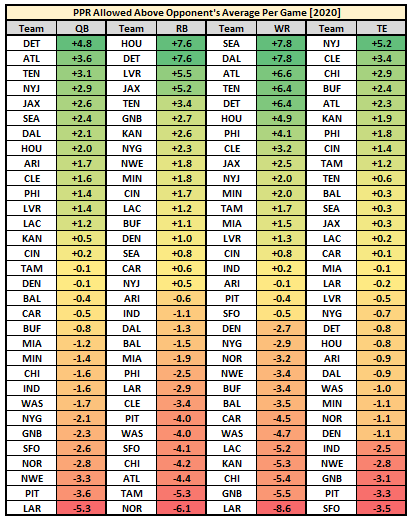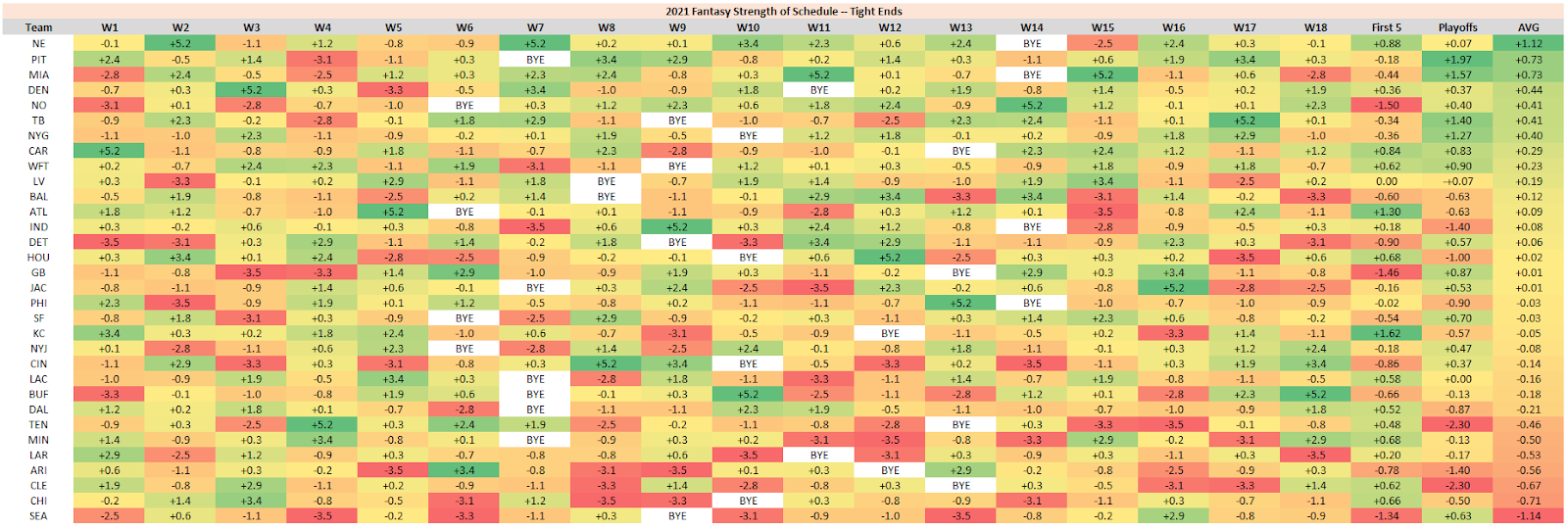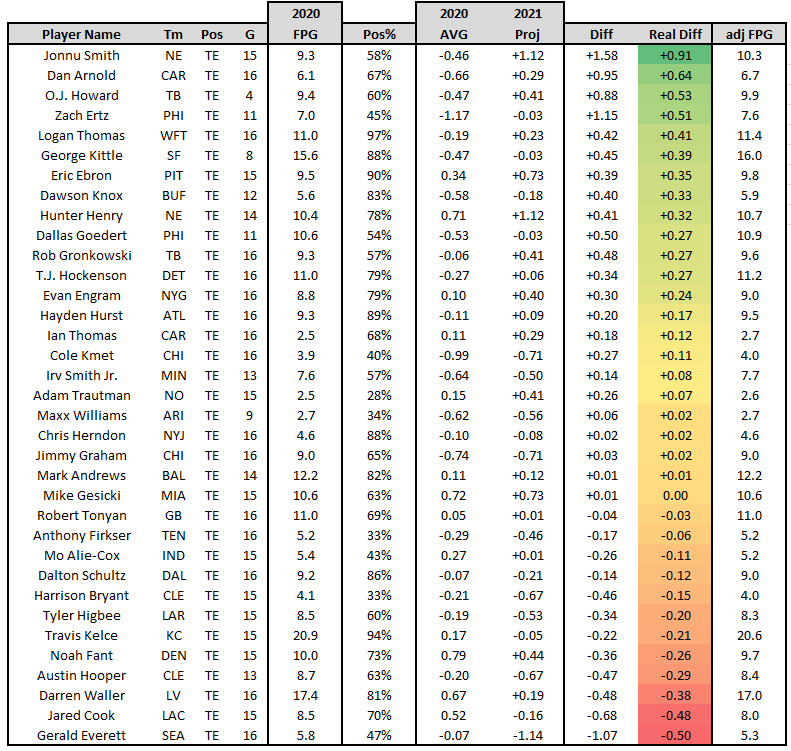Other Positions: Quarterbacks Running Backs Wide Receivers
Never Bury the Lede: The difference between Jonnu Smith’s schedule last year and his schedule this year was the difference between him finishing 15th and 11th in fantasy points per game.
Which tight ends have the toughest or easiest fantasy schedules this year? Which tight ends had the toughest or easiest schedules last year? Or, what about the toughest or easiest schedules in the fantasy postseason? Or to start the season? Which tight ends saw their schedules improve the most or least? How big of an impact was that change in schedule? Can we quantify that change in real terms using fantasy points?
Luckily for our subscribers, we can answer all of these questions and more. But in order to do so, we first had to quantify strength of schedule. This is typically done by calculating a defense’s FPG allowed average, and then looking at the average for all players over a full season. This will also be our approach; however, we’ll be taking things one step further — we’re going to use a control for the opposing offense by measuring FPG over an opponent’s average.
For instance, last season, opposing tight ends averaged +5.2 fantasy points per game over their season-long average when facing the Jets, which ranked worst in the league. (The Jets were the most favorable fantasy matchup for opposing tight ends — worth, on average, an additional 5.2 fantasy points per game.) On the opposite end of the spectrum, tight ends fell short of their season-long average by 3.5 points when facing the 49ers, which ranked best in the league. (The 49ers were the toughest fantasy matchup for opposing tight ends.) Calculating these numbers for all teams and then applying the full-season average for all players quantifies in real terms which players had the easiest and most difficult schedules for fantasy last year. We can also use these numbers to project out strength of schedule for each team and each position in 2021.
While this methodology isn’t perfect — of course roster turnover and coaching changes will complicate things — strength of schedule doesn’t not matter. This data is still far more actionable than it is not. In fantasy football — like in poker — there may only be small edges to be gained, but those small edges can be compounded to yield a massive advantage. And they must be taken advantage of … and are, by the most dominant players. That’s the case with strength of schedule. It’s another small edge to be realized, and at the polar extremes, it might matter a lot more than you’d expect.
Last season, Jonnu Smith had the 11th toughest schedule among all fantasy tight ends. His average matchup was worth -0.46 [team tight end] FPG. Because he was responsible for 58% of the fantasy points generated by Tennessee’s tight ends last year (in games active), we can say that — adjusted for strength of schedule, or if he had a perfectly average strength of schedule last year — he would have scored an additional +0.26 fantasy points per game. Looking forward, Smith’s schedule is much improved (most-improved at the position), very soft (softest at the position), and worth an additional +1.12 fantasy points per game in real terms. Essentially, if he had this schedule last year, he should have scored an additional +0.64 in real terms (adjusting for usage). This would push his total up to 10.3 FPG, which would have ranked 11th (four spots higher than his actual finish).
Clearly, strength of schedule – something totally outside of a player’s control and entirely due to luck – can have a big impact for fantasy.
Best Overall Schedule (2020)
1. Noah Fant, Average Matchup: +0.79
2. Mike Gesicki (+0.72)
3. Hunter Henry (+0.71)
4. Darren Waller (+0.67)
5. Jared Cook (+0.52)
Worst Overall Schedule (2020)
1. Jimmy Graham (-0.74)
2. Dan Arnold (-0.66)
3. Irv Smith Jr. (-0.64)
4. George Kittle (-0.47)
5. Jonnu Smith (-0.46)
2021 Schedule
PDF Download available here.
CSV Download available here.
Best Overall Schedule (Weeks 1-17)
1. Jonnu Smith/Hunter Henry (+1.12)
t2. Eric Ebron/Pat Freiermuth (+0.73)
t2. Mike Gesicki (+0.73)
4. Noah Fant (+0.44)
t5. Adam Trautman (+0.41)
t5. Rob Gronkowski/Cameron Brate/O.J. Howard (+0.41)
Worst Overall Schedule (Weeks 1-17)
1. Gerald Everett (-1.14)
2. Cole Kmet/Jimmy Graham (-0.71)
3. Austin Hooper/Harrison Bryant (-0.67)
4. Maxx Williams/Other Arizona TE (-0.56)
5. Tyler Higbee (-0.53)
Off to a Hot Start (First Five Weeks)
1. Travis Kelce (+1.62)
2. Kyle Pitts/Hayden Hurst (+1.30)
3. Jonnu Smith/Hunter Henry (+0.88)
4. Dan Arnold/Other Carolina TE (+0.84)
5. Irv Smith Jr. (+0.68)
Slow Starters (First Five Weeks)
1. Adam Trautman (-1.50)
2. Robert Tonyan (-1.46)
3. Gerald Everett (-1.34)
4. T.J. Hockenson (-0.90)
5. Drew Sample (-0.86)
Best Playoff Schedule (Weeks 15-17)
1. Eric Ebron/Pat Freiermuth (+1.97)
2. Mike Gesicki (+1.57)
3. Rob Gronkowski/Cameron Brate/O.J. Howard (+1.40)
4. Evan Engram (+1.27)
5. Logan Thomas (+0.90)
Worst Playoff Schedule (Weeks 15-17)
t1. Austin Hooper/Harrison Bryant (-2.30)
t1. Anthony Firkser (-2.30)
t3. Maxx Williams/Other Arizona TE (-1.40)
t3. Jack Doyle/Mo-Alie Cox (-1.40)
5. Texans TE (-1.00)
Schedule Change (In Real Points)
Most Improved Schedule
1. Jonnu Smith (+0.91)
2. Dan Arnold (+0.64)
3. O.J. Howard (+0.53)
4. Zach Ertz (+0.51)
5. Logan Thomas (+0.41)
Least Improved Schedule
1. Gerald Everett (-0.50)
2. Jared Cook (-0.48)
3. Darren Waller (-0.38)
4. Austin Hooper (-0.29)
5. Noah Fant (-0.26)
Thoughts/Notes/Dank Stats
- For full transparency, strength of schedule is simply less important for tight ends than any for any of the other positions. However, that’s also captured in our results to some degree. The numerical rating for the most-improved tight end (+0.91) is well below that of the most-improved quarterback (+1.62), running back (+1.32), and wide receiver (+1.96).
- No tight end will benefit more from an improved schedule this year than Jonnu Smith. (Explained in more detail in the introduction.)
- Adam Trautman (-1.50), Robert Tonyan (-1.46), Gerald Everett (-1.34), and T.J. Hockenson (-0.90) all have very difficult schedules during the first five weeks of the season, making them ideal in-season trade targets. Trautman is one of my favorite late-round sleepers (ADP: TE22) and his overall schedule ranks fifth-easiest (+0.41). I also think Everett (ADP: TE25) is being massively underrated in best ball leagues. Pete Carroll revealed during the team’s Day 2 Post-Draft Press Conference that he views Everett as the team’s No. 3 receiver. Unfortunately, Everett also has the worst overall schedule of any TE, worth roughly 1.14 FPG off of his schedule-agnostic projections.
- Tyler Higbee has the league’s fifth-toughest overall schedule this season (-0.53), only slightly worse than his schedule last year (-0.19), but I like him a lot as an upside play at current ADP (TE12). Gerald Everett only missed time during one year of his four-year career — in 2019, he played just four snaps between Weeks 13-17. Over that stretch Higbee averaged 11.2 targets, 104.4 yards, and 23.8 DK FPG, hitting 100 yards in 4 of those 5 games. With Everett now out of the picture, could Higbee return to his fleeting former glory? Maybe. More than likely McVay continues with his typical shenanigans, replacing Everett with Brycen Hopkins and continuing to underutilize Higbee. Still, at a dead position, Higbee’s upside is well worth chasing at cost.
- Miami's receiver room is a lot more crowded this year, which is to say there's a lot more competition for targets, but Mike Gesicki has the league's third-softest overall schedule (+0.73) and the second-best playoff schedule (+1.57). He’s not really a draft-target for me, but a case can be made. Gesicki averaged 7.8 targets, 57.8 yards, and 15.6 FPG over his final five games. And he was also QB Tua Tagovailoa’s most-targeted receiver in games active (16.3% target share).
- Evan Engram has the league's seventh-softest overall schedule (+0.40) and the fourth-best playoff schedule (+1.27). In his first season back from a Lisfranc injury, Evan Engram’s FPG average dropped from 13.7 in 2019 to 8.9 in 2020 (a 35% decrease). FantasyPoints’ own injury expert Edwin Porras warned us last year, “Lisfranc injuries reduce NFL offensive players’ on-field production by an average of 21% in the first season following surgery. This production seemed to level off after the second year and returned to baseline.” If Porras is right, Engram should be an immense value at current ADP (TE15).
- Logan Thomas has the fifth-softest playoff schedule (+0.90) and his overall schedule ranks as fifth most-improved (+0.41). The 29-year-old Thomas was highly impressive in his first full season of real work, earning 110 targets and rarely leaving the field. He led the position in routes run (609) and route share (91%), well ahead of names like T.J. Hockenson (461, 65%) and Robert Tonyan (371, 65%) who are both going before him in best ball leagues. From Week 6 until the end of the season, Thomas ranked third in targets per game (7.2), fifth in YPG (52.2) and third in FPG (13.2). And from Week 12 on, he raised that average to 16.3 FPG.
- Have a difficult time choosing between George Kittle and Darren Waller? I slightly prefer Waller, but Kittle has the schedule advantage. Kittle has the sixth-biggest schedule improvement (+0.39) to Waller's third-worst (-0.38). Waller averaged 17.4 FPG to Kittle’s 15.6 FPG last year, but if schedule-adjusted that gap shrinks to 17.0 for Waller vs. 16.0 for Kittle. And perhaps you can take this even further if adjusting these numbers due to injury — Kittle dealt with a Grade 2 MCL sprain to his knee as well as a foot fracture and still returned by Week 16.
- Noah Fant's overall schedule ranks 4th-best (+0.44), but it's also a step down from the pillow-soft schedule he had last year (+0.79, softest at the position). Still, I like his odds of a breakout year, even though QB play is also a concern, as is increased target competition. But like Kittle, he’s also deserving of an injury-discount, playing through ankle and rib injuries for much of the season. If only removing the one game he played fewer than 10% of the team’s snaps, his FPG average jumps from 10.0 to 10.7. He'd also jump to 6th in targets per game (6.4) and 5th in YPG (48.1).










